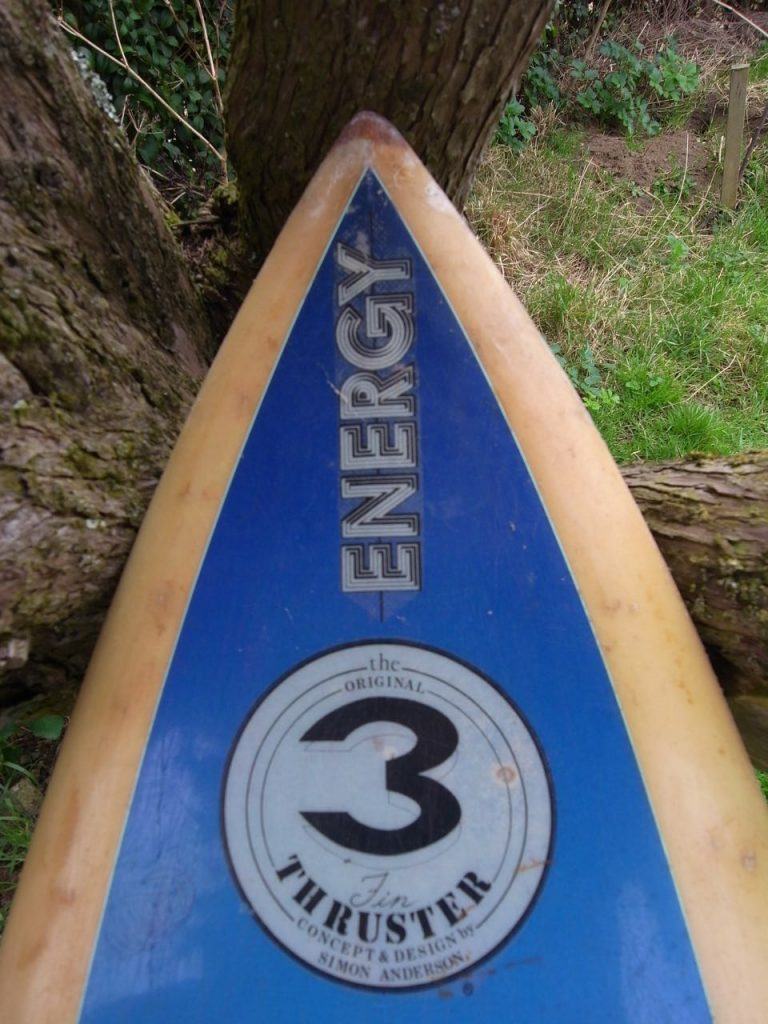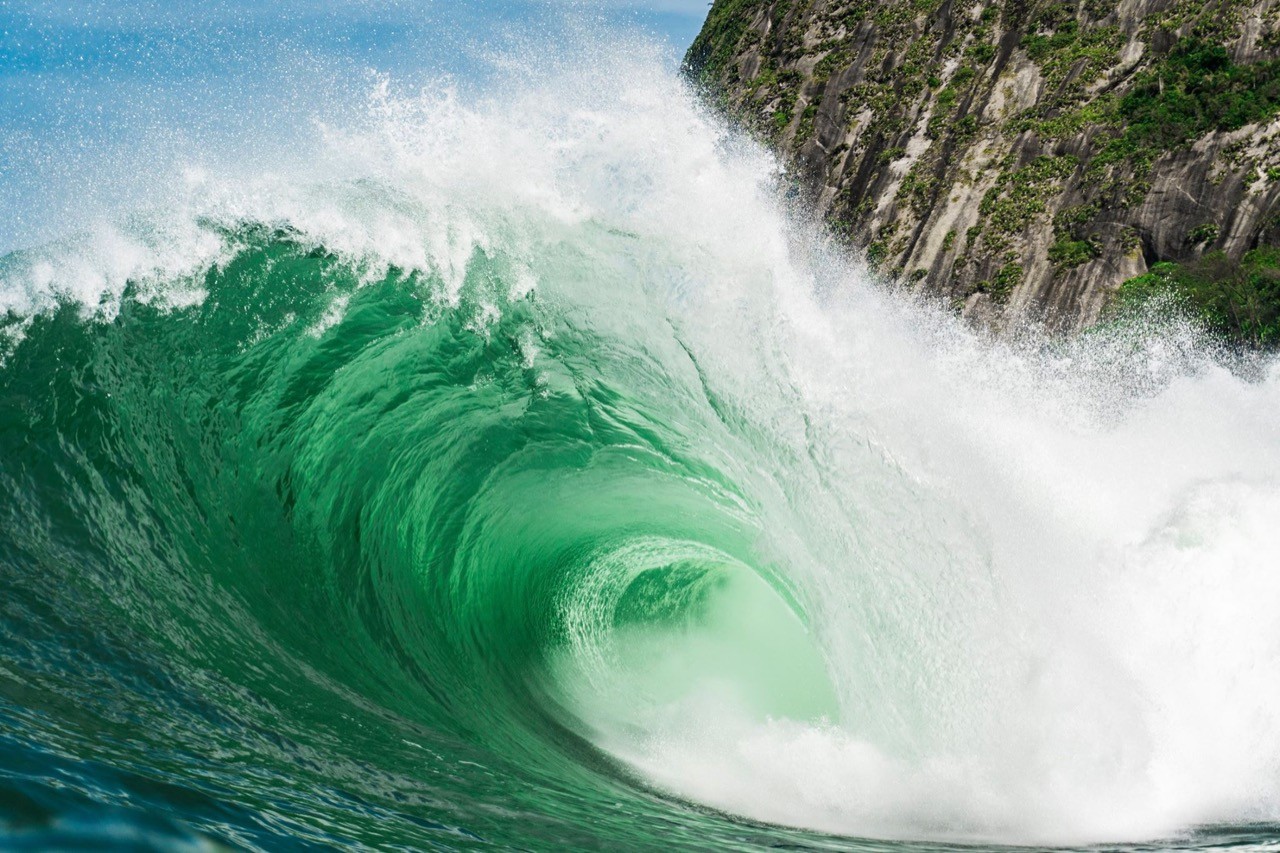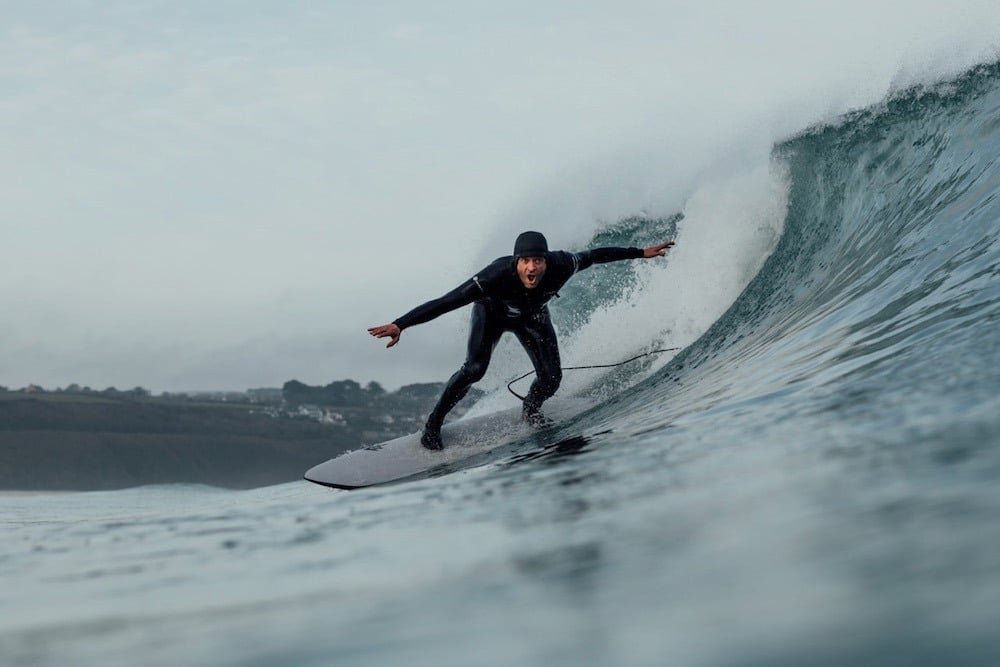Simon Anderson’s Board Design That Changed Surfing


Simon Anderson’s Energy Surfboards Thruster
Alf Alderson looks at how the Thruster revolutionised surfing for everyone from pro surfer to weekend warrior, and over thirty years after its introduction it’s still the most popular fin set up in the water.
Easter 1981, Victoria, Australia, and Simon Anderson paddles out into huge waves in the Bells Beach Surf Classic to change surfing for ever…
Leaving aside that the massive swell rolling ashore at Bells created what was one of the all-time Aussie surf contests, what really gave this event its place in surfing history is the fact that this was where Anderson was “Hoping to successfully introduce the Thruster design to the world”. And that he did, in no uncertain terms.

Anderson races a meaty lip
The well-built 6’ 3” native of North Narrabeen was a smooth, stylish, graceful surfer who had for many years competed with no small degree of success on the pro contest scene around the world, but had always been hampered by his sturdy physique, particularly in smaller waves where the board designs of the day generally favoured lighter, more nimble surfers.
“I was wrestling with the dilemma of having a twin-fin that I liked in small one- to two-foot surf and a single fin board that was good in all surf but not cutting it in competition in waves from one- to three or four feet. The big problem for me was the three to four-foot region, and finding a board for this that had speed and hold.”
The evolution of surfboard design
Bearing in mind that the competition scene expanded in the late 70s and smaller waves were becoming the norm in the majority of surf contests it’s easy to see why this would be a serious concern to Anderson, who didn’t just compete at the highest level but also designed and built his own boards from his Energy Surfboards factory in Brookvale, Sydney. And this ‘grey area’ is also the size of wave in which the majority of recreational surfers find themselves paddling out most of the time.
A year before the Bells Beach event Anderson had seen a board that a friend from Narrabeen, Frank Williams, was “mucking around” with. Williams had a twin-fin onto which he’d added a large central fin which he then sanded down to a little half-moon shape, what he called a ‘trigger point’ which worked to provide a compromise between the looseness of a ‘twinnie’ and the stiffness of a single fin.
Anderson could see the logic in this and decided to give it a go for himself, although he was more radical in designing his own tri-fin setup making the central fin the same size as the two outriders. All three fins were slightly smaller than those on a twin-fin, with the central fin set three inches from the tail and the two other fins set 11 inches forward of the tail close to the rail, in the same way as a twin-fin.
The birth of the Thruster
He called his new design a ‘Thruster’, which pretty much described the way this fin configuration worked, giving the board more drive and direction – in effect more ‘thrust’ – out of turns. Anderson made his first prototype Thruster in October 1980 and took it with him on the pro tour to Hawaii and California, where he was able to hone his riding before going on to his epic win at Bells on a more refined design, which was followed immediately after by another famous victory at the Coke Surfabout in Sydney.
“It took two or three boards before I got the Thruster set up to work to my satisfaction – the major problem was getting the balance in the shape right to make it work in varying conditions and sizes of surf”.

1981 Simon Anderson Thruster
Other shapers had also been experimenting with similar designs around this time, as Anderson is happy to acknowledge, even admitting that if he hadn’t come up with the Thruster someone else would have; but he was the first – he was the one who had essentially created a revolution right across the surfing world.
Over three decade on he says I believed from the first board and probably the first wave that it would be massive in surfing but it took a fair bit of time and winning events to establish this but to tell you the truth it wasn’t a focus of mine. I was happy to develop my own equipment and present it as an option to the public as a surfboard maker”.
“I think the important thing at the time was that it allowed the average surfer to have one board that worked really well in surf from one- or two-feet up to six feet.”
Prior to this I think everyone suffered from either having a twinnie that was lively and a lot of fun in small surf but generally too hard to handle in more challenging conditions, or a single fin board that was great for waves with some speed but not exciting in small surf”.

1981 Simon Anderson Thruster 3 Energy Surfboards
In effect Anderson’s innovation gave surfboards a versatility they had never previously had – thanks to the central fin you had the power and torque of a single fin with the looseness and performance of a twin-fin. And what’s more, a tri-fin doesn’t just work admirably well in Anderson’s so-called ‘grey area’, it also performs in big waves too, as its inventor proved in the triple overhead surf of the Bells Beach Classic, an event he later described in another classic understatement as turning out to be “pretty significant”.
The reasons for the “significance” are two-fold. It’s often the case that at the highest levels of sport changes in equipment design only impact on professionals whose skill and talent allows them to exploit those design tweaks to the maximum; and design changes can often be costly and as such not readily accessible to recreational practitioners.
“But the ‘Thruster’ could improve pretty much anyone’s surfing literally overnight (and even made learning to surf easier) and it added little if anything to the cost of a surfboard.”
Within months of Simon Anderson’s success at Bells Beach, Energy Surfboards was selling Thrusters not just across Australia but all around the surfing world. Within a couple of years it was the fin set up of choice on virtually every beach, reef and point break on the planet, being used by everyone from manic groms to grizzled old surf dogs as well as the very best surfers around – it’s a fact that since 1982 the winner of every ASP world surfing title has ridden some variation of a three-fin configuration.
Shaping Innovations in board design
Ironic then that Anderson never got round to patenting the design, which would undoubtedly have made him a very rich man. Chasing the big bucks is not his style though – he was busy competing on the world circuit, didn’t relish the thought of being stuck in musty court rooms trying to enforce patents and as he’s since laconically remarked “Bad luck – there goes another fortune slipped through the fingers”.
He’s also characteristically modest about the overall impact of the Thruster on surfing. “There have been many important developments since in board design, especially in the shape of the board, and these have taken the sport to a far higher level of performance than the 1980s.

Simon Anderson off the top
“Shaping innovations like the no nose in 1980; plan shape and rail improvements plus channels through the 80s; narrow boards with increased rocker and then concave bottoms in the early 90s; and recently quad boards. As for the next big thing? If I knew what that was I would be doing it now!”
Interestingly Anderson feels “…that if board design is to evolve further it will come from surfers at the upper levels of surfing, introducing board innovations allowing them to surf in a way that we could not possibly imagine”.
Much like the Thruster did, then…
For Simon’s latest designs head to simonandersonsurfboards.com
Video by Rip Curl: Bell Beach Surf Classic 1981
Feature Image: Simon Anderson, still ripping today on his Thruster design
Last updated on May 7, 2018Have you subscribed to our Newsletter or Podcast? Listen to us on Apple Podcast and Spotify and follow us on Facebook, Instagram Twitter and YouTube.








